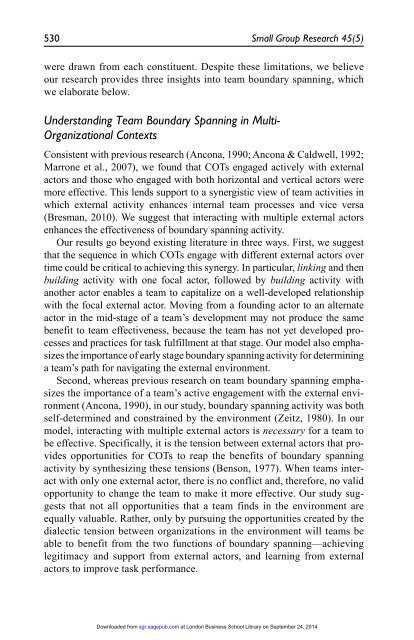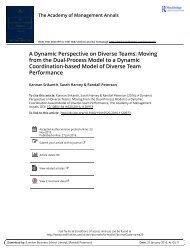The Process of Team Boundary Spanning in Multi-Organizational Contexts - Sarah Harvey, Randall S. Peterson, and N. Anand
Work teams must increasingly operate in complex environments characterized by multiple external actors beyond team and organizational boundaries. Although previous research demonstrates the importance of boundary spanning activities to team effectiveness, it reveals relatively little about the process of boundary spanning in these environments. In this article, we investigated the processes of boundary spanning across multiple external actors in 10 cross-organizational teams. We identified three sequences for reaching out to external actors: (a) moving inside-out from vertical actors inside the host organization to horizontal actors outside of the host organization, (b) moving outside-in from horizontal actors to vertical, and (c) staying-inside with vertical actors from the host organization. Our observations suggest that inside-out and outside-in sequences were more successful than simply pleasing the host organization. We build on our empirical findings to develop a process theory of how team boundary spanning activities across multiple external actors influence team effectiveness. Our research underscores the importance of a team’s interactions with actors in its external environment beyond those in an immediate supervisory role and provides insight into the dynamics of boundary spanning in multi-organizational contexts.
Work teams must increasingly operate in complex environments
characterized by multiple external actors beyond team and organizational
boundaries. Although previous research demonstrates the importance of
boundary spanning activities to team effectiveness, it reveals relatively little
about the process of boundary spanning in these environments. In this article,
we investigated the processes of boundary spanning across multiple external
actors in 10 cross-organizational teams. We identified three sequences for
reaching out to external actors: (a) moving inside-out from vertical actors inside
the host organization to horizontal actors outside of the host organization,
(b) moving outside-in from horizontal actors to vertical, and (c) staying-inside
with vertical actors from the host organization. Our observations suggest
that inside-out and outside-in sequences were more successful than simply
pleasing the host organization. We build on our empirical findings to develop
a process theory of how team boundary spanning activities across multiple
external actors influence team effectiveness. Our research underscores the
importance of a team’s interactions with actors in its external environment beyond those in an immediate supervisory role and provides insight into the
dynamics of boundary spanning in multi-organizational contexts.
Create successful ePaper yourself
Turn your PDF publications into a flip-book with our unique Google optimized e-Paper software.
530 Small Group Research 45(5)<br />
were drawn from each constituent. Despite these limitations, we believe<br />
our research provides three <strong>in</strong>sights <strong>in</strong>to team boundary spann<strong>in</strong>g, which<br />
we elaborate below.<br />
Underst<strong>and</strong><strong>in</strong>g <strong>Team</strong> <strong>Boundary</strong> <strong>Spann<strong>in</strong>g</strong> <strong>in</strong> <strong>Multi</strong>-<br />
<strong>Organizational</strong> <strong>Contexts</strong><br />
Consistent with previous research (Ancona, 1990; Ancona & Caldwell, 1992;<br />
Marrone et al., 2007), we found that COTs engaged actively with external<br />
actors <strong>and</strong> those who engaged with both horizontal <strong>and</strong> vertical actors were<br />
more effective. This lends support to a synergistic view <strong>of</strong> team activities <strong>in</strong><br />
which external activity enhances <strong>in</strong>ternal team processes <strong>and</strong> vice versa<br />
(Bresman, 2010). We suggest that <strong>in</strong>teract<strong>in</strong>g with multiple external actors<br />
enhances the effectiveness <strong>of</strong> boundary spann<strong>in</strong>g activity.<br />
Our results go beyond exist<strong>in</strong>g literature <strong>in</strong> three ways. First, we suggest<br />
that the sequence <strong>in</strong> which COTs engage with different external actors over<br />
time could be critical to achiev<strong>in</strong>g this synergy. In particular, l<strong>in</strong>k<strong>in</strong>g <strong>and</strong> then<br />
build<strong>in</strong>g activity with one focal actor, followed by build<strong>in</strong>g activity with<br />
another actor enables a team to capitalize on a well-developed relationship<br />
with the focal external actor. Mov<strong>in</strong>g from a found<strong>in</strong>g actor to an alternate<br />
actor <strong>in</strong> the mid-stage <strong>of</strong> a team’s development may not produce the same<br />
benefit to team effectiveness, because the team has not yet developed processes<br />
<strong>and</strong> practices for task fulfillment at that stage. Our model also emphasizes<br />
the importance <strong>of</strong> early stage boundary spann<strong>in</strong>g activity for determ<strong>in</strong><strong>in</strong>g<br />
a team’s path for navigat<strong>in</strong>g the external environment.<br />
Second, whereas previous research on team boundary spann<strong>in</strong>g emphasizes<br />
the importance <strong>of</strong> a team’s active engagement with the external environment<br />
(Ancona, 1990), <strong>in</strong> our study, boundary spann<strong>in</strong>g activity was both<br />
self-determ<strong>in</strong>ed <strong>and</strong> constra<strong>in</strong>ed by the environment (Zeitz, 1980). In our<br />
model, <strong>in</strong>teract<strong>in</strong>g with multiple external actors is necessary for a team to<br />
be effective. Specifically, it is the tension between external actors that provides<br />
opportunities for COTs to reap the benefits <strong>of</strong> boundary spann<strong>in</strong>g<br />
activity by synthesiz<strong>in</strong>g these tensions (Benson, 1977). When teams <strong>in</strong>teract<br />
with only one external actor, there is no conflict <strong>and</strong>, therefore, no valid<br />
opportunity to change the team to make it more effective. Our study suggests<br />
that not all opportunities that a team f<strong>in</strong>ds <strong>in</strong> the environment are<br />
equally valuable. Rather, only by pursu<strong>in</strong>g the opportunities created by the<br />
dialectic tension between organizations <strong>in</strong> the environment will teams be<br />
able to benefit from the two functions <strong>of</strong> boundary spann<strong>in</strong>g—achiev<strong>in</strong>g<br />
legitimacy <strong>and</strong> support from external actors, <strong>and</strong> learn<strong>in</strong>g from external<br />
actors to improve task performance.<br />
Downloaded from sgr.sagepub.com at London Bus<strong>in</strong>ess School Library on September 24, 2014
















